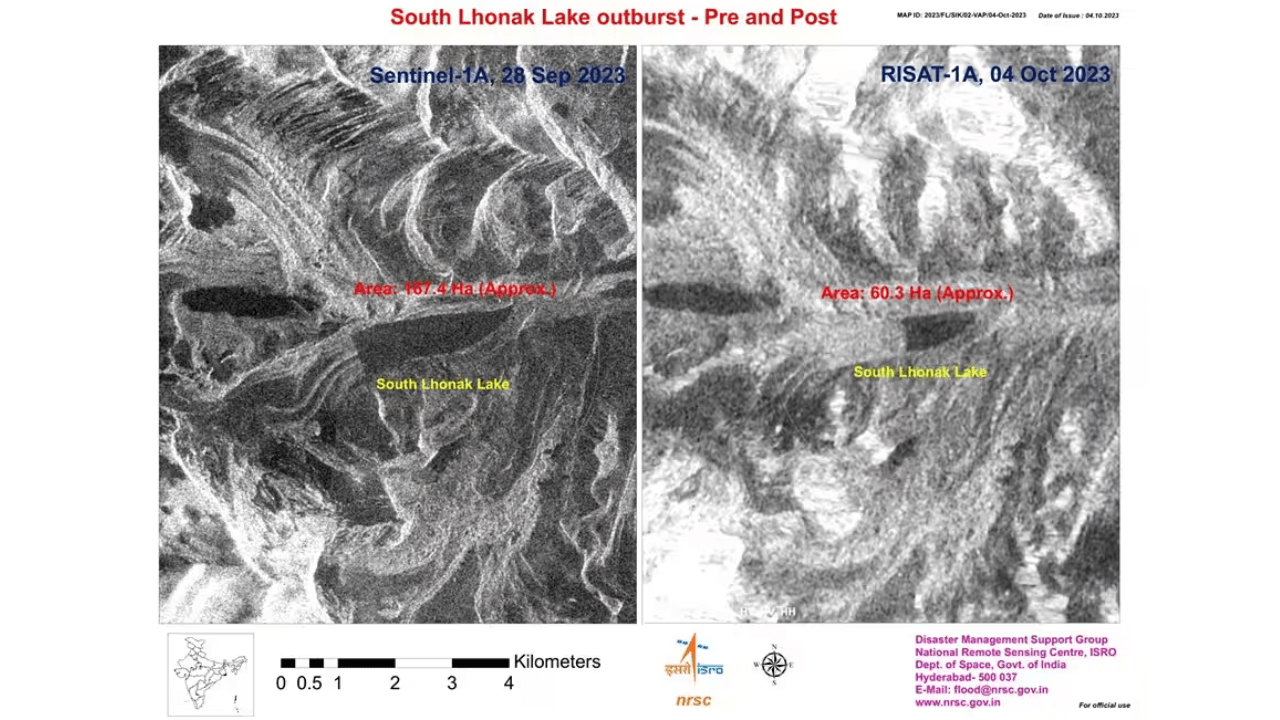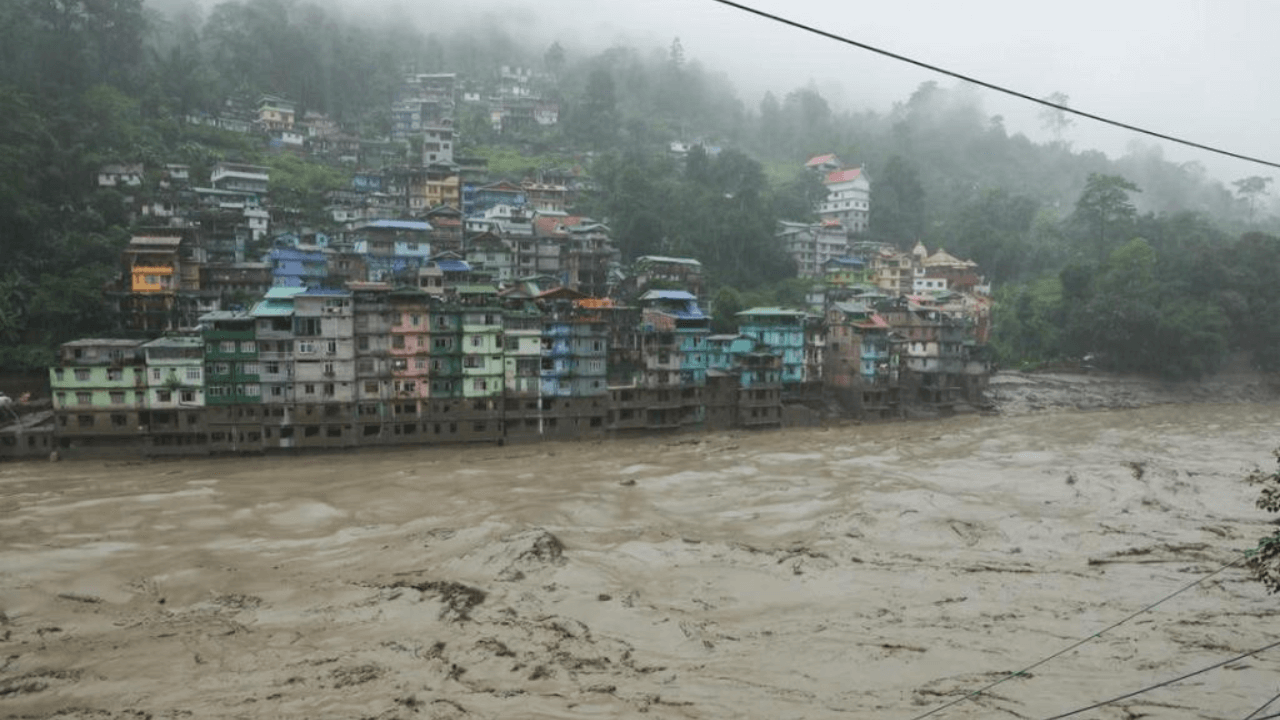Sikkim Flood
The situation in Sikkim is deeply concerning. As of October 5th, Thursday morning, a tragic incident occurred where fourteen people have lost their lives, and 102 individuals are reported missing. Among the missing, at least 23 are Army personnel. This devastating event was triggered by the bursting of the South Lhonak Lake, a glacial lake located in the state’s northwest at an elevation of 17,000 feet. The lake’s rupture was a consequence of incessant rainfall, resulting in the release of water into downstream areas. It is a challenging time for the affected region, and efforts are underway to provide support and assistance to those affected by this natural disaster.
More About the News
The overflow of the South Lhonak Lake in North Sikkim led to a significant increase in water levels in the Teesta River, resulting in flooding across several districts. The affected districts include Mangan, Gangtok, Pakyong, and Namchi. The Sikkim State Disaster Management Authority (SSDMA) reported that the lake outburst caused a surge in water levels with extremely high velocities, reaching approximately 15 meters per second. This surge exceeded the capacity of the Centre Water Commission (CWC) Melli site, measuring 227 meters, by approximately 3 meters above the danger level.
It’s important to note that for several years, various studies have highlighted the rapid growth of South Lhonak Lake, primarily due to glacier melting, making it vulnerable to glacial lake outburst floods (GLOF). This event underscores the critical importance of monitoring and managing glacial lakes in regions susceptible to such natural hazards.
What is GLOF?
Glacial lakes, such as South Lhonak Lake, are bodies of water that form in front of, on top of, or beneath melting glaciers. As these lakes expand, they become increasingly hazardous because they are typically dammed by unstable ice or sediment composed of loose rock and debris. If the boundary holding them in breaks, it can result in the sudden release of massive amounts of water rushing down the mountainside, leading to flooding in downstream areas. This natural phenomenon is known as a glacial lake outburst flood (GLOF).
Several factors can trigger GLOFs, including earthquakes, extremely heavy rainfall, and ice avalanches. These lakes are commonly found in steep, mountainous regions, making them susceptible to landslides or ice avalanches that can directly impact the lakes. Such events can displace water, causing it to breach the natural dam and inundate downstream areas.
A tragic example of this occurred in 2013 in Uttarakhand’s Kedarnath region when flash floods and a GLOF, caused by the Chorabari Tal glacial lake, resulted in the loss of thousands of lives. It serves as a stark reminder of the potential dangers associated with glacial lakes in mountainous regions.
How did South Lhonak Lake become susceptible to GLOF?
The rapid melting of glaciers in the Sikkim Himalayas, driven by rising global temperatures, has led to the formation and expansion of numerous glacial lakes in the region. According to the Sikkim State Disaster Management Authority and a 2020 report by Mongabay, there are currently more than 300 glacial lakes in the Sikkim Himalayan region. Out of these, 10 have been identified as vulnerable to outburst floods, including the South Lhonak Lake.

South Lhonak Lake has been closely monitored by government authorities for years. A report from the Sikkim Forest and Environment Department noted a significant increase in the lake’s area over the past five decades. It highlighted that Lhonak Lake had grown nearly 1.5 times and South Lhonak nearly 2.5 times their initial size in 1989.
Furthermore, the report pointed out that seismic activity, such as earthquakes, near the parent glacier feeding South Lhonak Lake, as well as future earthquakes, could potentially trigger glacial lake outburst flood (GLOF) events. This underscores the ongoing risk associated with these glacial lakes and the need for proactive monitoring and risk mitigation measures in the face of climate change.
Earlier Actions Taken by the Sikkim Government
In 2016, in an effort to mitigate the risk associated with South Lhonak Lake, members of the Sikkim State Disaster Management Authority and Sikkim’s Department of Science and Technology and Climate Change, along with others, took steps to syphon off water from the lake.
Under the supervision of innovator Sonam Wangchuk, authorities installed three eight-inch wide and 130-140 meters long High-Density Polyethylene (HDPE) pipes in the lake to remove water. This syphoning process was carried out at a rate of 150 liters of water per second, as reported by the Sikkim SDMA. The aim of this initiative was to reduce the water volume in the lake and, consequently, the risk of a GLOF event. Such measures can help manage the potential hazards posed by glacial lakes in vulnerable regions.
- Weekly Current Affairs 2025 PDF For Bank, SSC, UPSC Exams
- Unsung Heroes of India: 10 Unknown Freedom Fighters You Should Know
- 26 December Current Affairs 2023 in English
- Daily Current Affairs 2025, Check Today’s Current Affairs
- April Month Current Affairs 2024, Download PDF
- June Month Current Affairs 2024, Download PDF

Hello, I’m Aditi, the creative mind behind the words at Oliveboard. As a content writer specializing in state-level exams, my mission is to unravel the complexities of exam information, ensuring aspiring candidates find clarity and confidence. Having walked the path of an aspirant myself, I bring a unique perspective to my work, crafting accessible content on Exam Notifications, Admit Cards, and Results.
At Oliveboard, I play a crucial role in empowering candidates throughout their exam journey. My dedication lies in making the seemingly daunting process not only understandable but also rewarding. Join me as I break down barriers in exam preparation, providing timely insights and valuable resources. Let’s navigate the path to success together, one well-informed step at a time.






